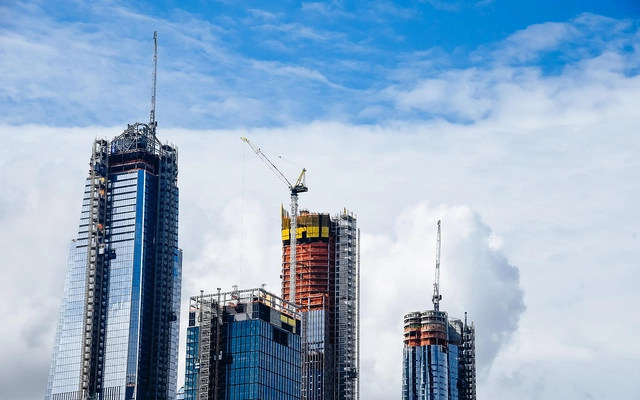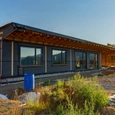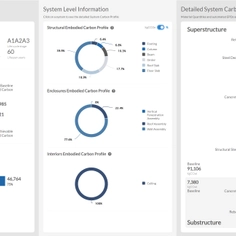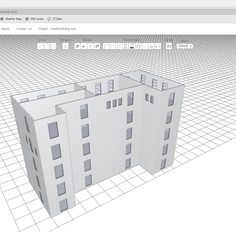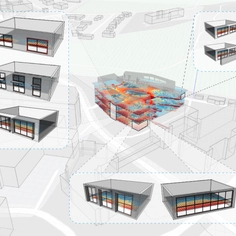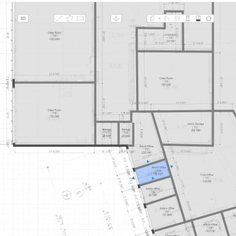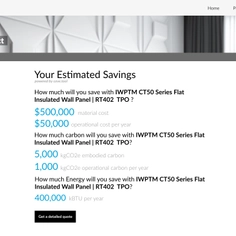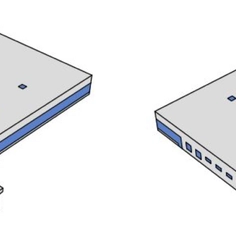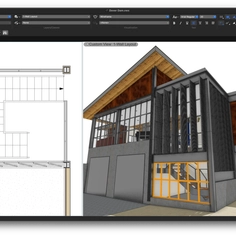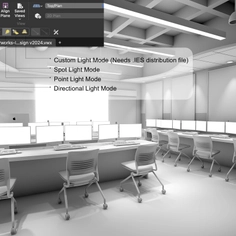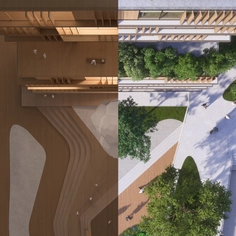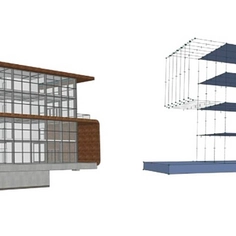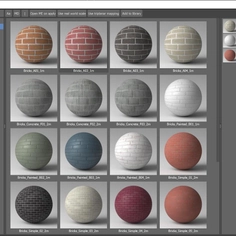-
Use
Streamlined automated analysis to help architects, engineers and contractors achieve energy, daylight, glare, water, carbon targets while reducing construction cost -
Applications
Cost vs energy optimization, automated energy modeling, rapid daylight, glare, shadow, radiation, quality views, COVID occupancy assessment score, façade analysis, indoor and outdoor water use, architecture 2030, LEED, life cycle optimization, embodied and operational carbon, report generation, and multidisciplinary team integration -
Characteristics
Intuitive web-app for Revit, Rhino, Sketch-up, and more
Embodied carbon is crucial to consider in building projects as it accounts for a substantial portion of a building's carbon footprint. Strategies like utilizing recycled materials, optimizing material use, selecting low-carbon materials, and adopting alternative construction methods to minimize waste and energy consumption are effective in reducing embodied carbon. By incorporating sustainable design strategies into building construction, multiple benefits can be achieved. These include lowering energy costs, improving occupant comfort and well-being, and aligning with the increasing trend toward green and sustainable living.
cove.tool presents the following guide to understanding and reducing the carbon emissions of an architectural project throughout its various stages.
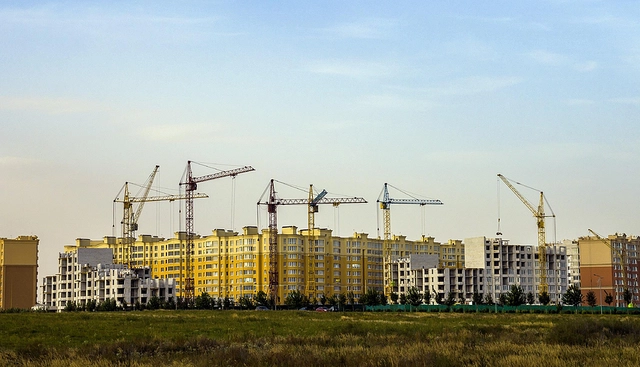 |
What is Embodied Carbon?
Embodied carbon refers to the CO2 emissions associated with the production, transportation, and disposal of materials and products over their entire life cycle, including extraction, manufacturing, construction, use, and end-of-life. Embodied carbon accounts for the emissions associated with building materials such as concrete, steel, and wood, and can represent a significant portion of the total carbon footprint of a building or infrastructure project.
What are Carbon Emissions?
Carbon emissions refer to the direct or indirect release of CO2 into the atmosphere from burning fossil fuels, industrial processes, land-use changes, and other human activities. These emissions are the primary driver of climate change and reducing these gasses is crucial for mitigating environmental impacts. Reducing both carbon emissions is essential for achieving sustainability goals, as they contribute to the depletion of natural resources, pollution, and climate change.
 |
Reducing Embodied Carbon
The creation of a habitat, whether it be a building, a house, or any other structure, involves four primary stages - study, design, construction, and use. Each of these stages presents opportunities to reduce carbon emissions and promote sustainable practices, and it is important to consider carbon reduction objectives throughout the entire process.
Study
A comprehensive understanding of the site and its context is essential for developing an appropriate design that minimizes environmental impact. Choosing renewable, recycled, or minimally processed materials allows for the creation of sustainable and environmentally responsible buildings. Low-embodied carbon materials exhibit a lower carbon footprint compared to traditional building materials. By studying the lifecycle of building materials, from production to disposal, it is possible to determine the amount of carbon emissions generated at each stage and identify opportunities for improvement.
Tools like cove.tool are valuable resources for obtaining and organizing project information. With analysis.tool, designers can easily conduct various building analyses, including energy modeling, daylighting analysis, and embodied carbon analysis. By inputting data such as building materials and construction methods, accurate carbon emissions estimates can be generated. The tool seamlessly integrates with popular design software like Rhino, SketchUp, and Revit, enabling designers to analyze their building designs quickly and effortlessly. The embodied carbon analysis feature helps designers estimate the carbon emissions associated with their design, allowing them to identify areas for reducing the building's environmental impact.
 |
Design
Design sets the foundation for the building’s entire lifecycle. Sustainable design strategies that help in reducing embodied carbon include:
- Selecting low-carbon materials
- Designing for efficiency and material optimization
- Using renewable energy sources during construction
- Promoting circular economy principles that reduce waste and promote material reuse and recycling
- Passive solar design: designing the building to maximize its exposure to the sun and using natural ventilation and shading to control the amount of heat gain and loss
- Optimizing the building’s orientation, window placement, and insulation, so it can naturally regulate its temperature
During the design phase, architects can utilize Building Information Modeling (BIM) software to visualize the energy performance of the building and experiment with various sustainable design strategies. Digital tools like analysis.tool can aid in conducting lifecycle assessments to select low-carbon materials with minimal environmental impact. The building's design can also incorporate energy-efficient systems such as HVAC, lighting, and water heaters, which can reduce energy consumption and decrease its carbon footprint. Engineers can rely on loadmodeling.tool to perform sizing calculations for mechanical systems.
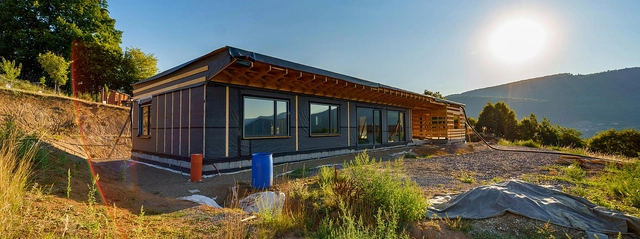 |
Construction
Construction practices play a crucial role in reducing a building’s embodied carbon. Sustainable construction practices can include:
- Buying local
Using locally sourced and renewable materials can reduce embodied carbon during construction by minimizing transportation emissions. As a bonus, using locally sourced materials also supports the local economy - Prefabrication
Prefabrication can significantly reduce the amount of waste generated during construction and lower the carbon emissions associated with transportation and assembly - Using low-carbon concrete alternatives
Concrete production is responsible for a significant amount of global carbon emissions, accounting for around 8% of the world’s greenhouse gas emissions. cove.tool offers revgen.tool to help architects make informed decisions about performance materials during the design phase - Adopting waste management practices
Waste management involves separating and recycling construction waste materials, which can reduce the amount of waste sent to landfills and lower the carbon emissions associated with waste disposal
 |
Use
Once the building is complete and in use, there are several strategies that can be implemented to continue to reduce carbon emissions. It is important to conduct a Lifecycle Assessment (LCA) of a building to fully understand its environmental impact and identify opportunities for improvement. After that, reducing embodied carbon can involve:
- Selecting low-carbon, recyclable or biodegradable materials
- Optimizing building design to minimize material use
- Prioritizing improvements by identifying materials and design elements with the highest environmental impact
- Upgrading insulation and installing energy-efficient systems and appliances to improve energy efficiency
- Using or switching to renewable energy sources
- Considering end-of-life options such as designing for deconstruction and material reuse
- Promoting sustainable behavior among occupants to reduce energy consumption and waste
 |
Digital tools and products play a crucial role in promoting sustainable practices and reducing carbon emissions throughout the entire building lifecycle. By incorporating these tools at each stage of the process, architects, engineers, and builders can create environmentally responsible, energy-efficient buildings that provide healthy, comfortable, and functional living spaces. Here are some ways in which cove.tool can help:
- Material selection
cove.tool can help users identify materials with lower embodied carbon by analyzing the embodied carbon of different material options - Design optimization
cove.tool can help users optimize the design of the building to reduce embodied carbon. For example, it can identify areas where structural elements can be minimized or eliminated, which can reduce the amount of material required - Sustainability certifications
cove.tool can help users achieve sustainability certifications such as LEED and WELL by providing performance metrics and documentation required for certification. This can help increase the market value and sustainability of the building


